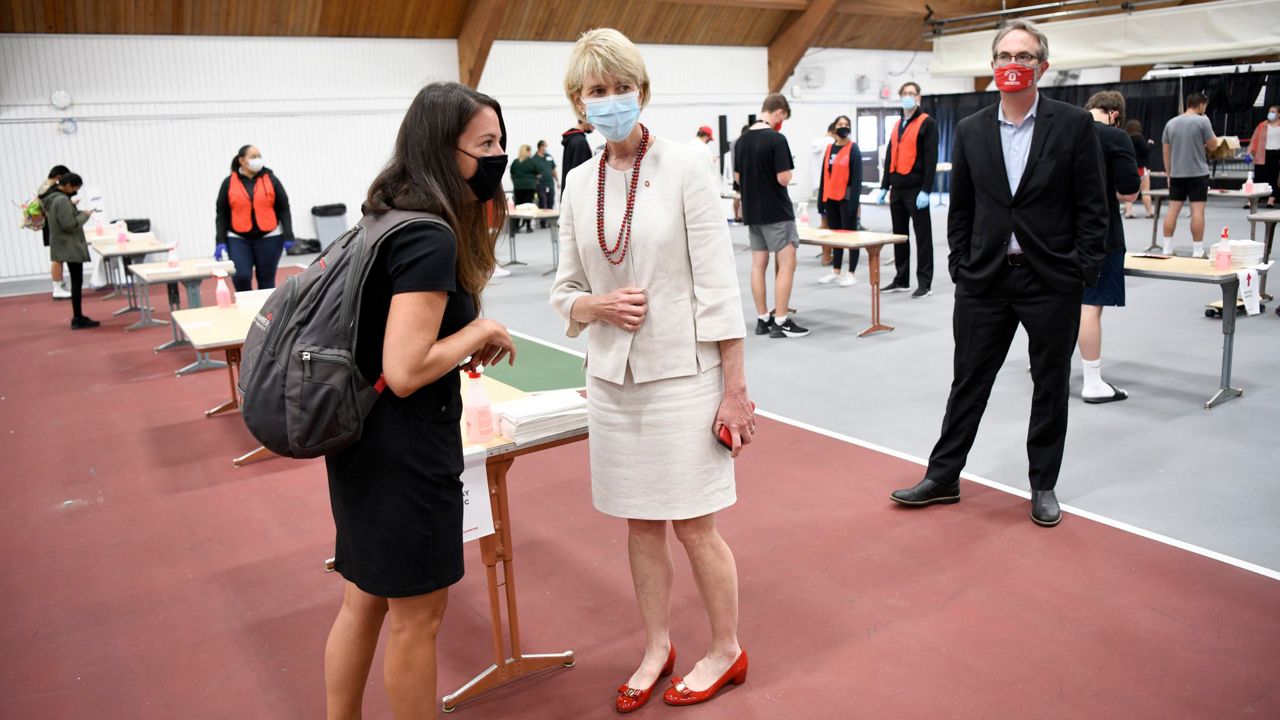COLUMBUS, Ohio — While the spread of COVID-19 at Ohio State University is trending downward, the university set a record this week no one wanted to see broken when its count of positive tests surpassed that of Marion Correctional Institution, making the outbreak at the Columbus campus Ohio’s largest so far.
The university’s dashboard showed 2,580 cumulative positive tests as of the latest update Friday evening. Ohio State's outbreak is among the largest of campus outbreaks nationally. The University of Georgia (3,538) and the University of Alabama (2,688) have reported more positive tests.
In response to this story, a university spokesman said that Ohio State enrolls more students than Georgia and Alabama. The spokesperson said the school has processed nearly 74,000 tests.
Ohio State President Kristina Johnson said this week the trends in the university’s testing data are “encouraging.”
The school’s seven-day average positivity rate for student testing is down to 2.8 percent from its peak of 5.9 percent, the school's dashboard shows.
The numbers look better on-campus, where the student positivity rate is 1.3 percent. For off-campus students, the university reports a 4.7 percent seven-day average positivity rate.
Earlier in September, the university began shuttling students who needed to quarantine to a nearby hotel that was contracted to scale up its number of beds. With the space expansion and with the first wave of students exiting quarantine, the university has lots of space available should its outbreak worsen. As of Thursday, 263 of its 962 beds are occupied.
The university announced last Friday it will cancel spring break next semester to reduce travel-related exposures. The school is testing about 20,000 students each week.
Two other Ohio colleges have tallied four-digit case numbers. University of Dayton officials are hopeful their outbreak is largely behind them. The school counts a total of 1,230 students cases, 50 of which are active infections. The university's seven-day positivity rate was 2.2 percent as of Sept. 17.
At Miami University, which drew headlines last week after a group of students decided to party despite having tested positive for the virus, the outbreak remains more active. Of the school’s cumulative count of 1,361 student cases, 528 are active.
Like at Ohio State, the rate of spread at Miami University appears to be trending downward. The school reports its seven-day average of new cases is now 26.7, down from a peak two weeks ago when the school was averaging more than 100 new cases per day.
The viral video of students partying was the result of an officer running a student’s ID in Ohio Highway Patrol’s Law Enforcement Automated Data System, which gives officers statewide access to positive COVID-19 test results from the last 30 days, an Ohio Department of Public Safety spokesperson said. The access to the test data allows officers to outfit themselves with proper PPE when they are dealing with Ohioans who have tested positive, the spokesperson said.
The University of Dayton said its public safety officers are also informed by dispatchers when they are responding to a residence with a known COVID-19 case, university officials said.
In the Miami University video, the officer ran the student’s ID as he pulled over to break up a gathering of more than 10 people. In Columbus, police have taken a different approach. Columbus police spokesman Sgt. James Fuqua said the department decided it would “not take extra steps” to break up parties near Ohio State, and would instead approach those gatherings as it would in a normal year.
The Miami University officer informed students they might face more trouble from the school than from him. Columbus police, on the other hand, have not been instructed to provide additional notification to Ohio State University of its responses to off-campus parties this year, Fuqua said. The university did issue interim suspensions to more than 100 of its students for off-campus gatherings.
On Thursday, Gov. Mike DeWine brought attention to a fourth Ohio college seeing spread of the virus. Kent State University has reported 69 cases as of Sept. 14. Recent spread of the virus at the Portage County college was enough to bring the county into the “red” status of the state’s virus tracker, which takes into account a variety of metrics to show where officials view outbreaks as most serious.
The county’s average daily cases per 100,000 people has increased from about 5.5 per day to now 11 per day, the governor said. In a small county that had a low rate of spread, it did not take case numbers on the scale of the other three campuses to bring the county into the red.
According to DeWine, 51 percent of Portage County’s cases this month are among people under 29.
“The majority of cases are being driven by activities in off-campus housing and to a lesser degree, Greek housing,” he said.
Following the announcement about the county’s movement to the red status, the university announced it would switch to takeout-only only options for its dining halls, and an administrator announced the school would only let students living on campus visit other students’ dorm rooms. The university is also asking students to report all out of state travel to its COVID Response Team prior to departure.
“The increase of positive cases related to Kent State and the city of Kent can be attributed largely to off-campus gatherings,” Interim Associate Provost for Academic Affairs Manfred van Dulmen said.



